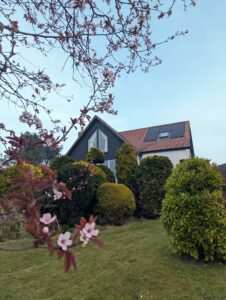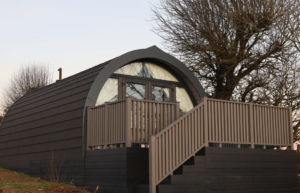We currently have two dwellings available for holiday rentals at Holmefield, outside Scarborough in North Yorkshire.
You can stay in Holmefield House (which sleeps 8) and our Gertie Cabin (which sleeps 4). You can book your stay here.
 |
 |
 |
 |
Our Ethos
We aim to make informed decisions, balancing cost and impact on our environment. Throughout the construction phase of the project, we invested in clean energy, installing solar panels, battery storage, and an air source heat pump to heat our homes. We chose more natural materials wherever budget allowed and it was practical to do so. We reused any materials from the original buildings that we could. We used second-hand furniture and furnishings wherever feasible and reasonable, which gives Holmefield its ‘unique’ internal style.
As we open Holmefield up to the public, we strive to use eco-friendly products. Everything from our loo roll to the washing up liquid is a considerate choice. We try, wherever possible, to make more sustainable choices and limit our impact on our environment. You can learn more about the decisions we’ve made and the research that has gone into making them with a little browse around this site, particularly in the Green Living > Build part of the menu.
You can stay with us to see how a fully solar-electric heating system looks, feels, and works in real terms. You can see for yourself how efficiently the central heating and hot water function in a working home. (And enjoy a lovely holiday at the same time!)
The Rebuild
Rebuilding Holmefield is a labour of love, and we are halfway there! We have refurbished the main house, updated the static caravan to a modern, efficient cabin, and we are currently rebuilding a derelict barn in the back paddock. We are still awaiting permission to modernise another derelict building onsite. The Holmefield project is built on a sympathetic approach to the outstanding natural beauty that surrounds it. Our fundamental goal is to minimise our impact on the surrounding environment, and limit our consumption of non-renewable energy in the home. We have worked these goals into the building design process as best we can, documenting our triumphs, failures, and compromises along the way.
We have meticulously researched sustainable alternatives to traditional energy and building methods. Along the way we found a minefield of greenwashing, green-based marketing, and extortionate pricing associated with ‘more sustainable’ alternatives. And, of course, like anything, there is rarely a clear cut, completely sustainable decision to be made. Sometimes we couldn’t be sure what was the most sustainable solution on the whole. We faced a number of difficult decisions.
Sometimes, like in the case of insulation, we accepted that traditional materials are less sustainable but decided they were still the best option because maintaining the same amount of heat retention with more natural materials would have cost us £20,000 more and reduced the liveable space in the building. Instead, we invested that £20,000 in renewable energy generation. We chose to prioritise the long-term sustainability of running the property over the one-time negative impact of using traditional insulation materials. Over time, the carbon footprint of the traditional materials is offset by the avoidance of consuming fossil fuels to heat the home.
We also agonised about what materials to use in cladding and decking. Timber may be a more natural material than composite, but may require deep chemical treatment, may be sourced from Russia, or may not last as long as alternatives in the elements. You can read more about the pros and cons of those alternatives here.